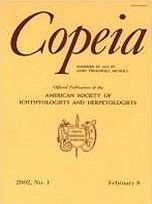From March 1998 to September 2000, we collected Atlantic Sharpnose Sharks, Rhizoprionodon terraenovae, in the north central Gulf of Mexico between St. Louis Bay, Mississippi and Perdido Bay, Alabama. Collections were typically made in the Mississippi Sound over a 4-day period, one site per day, using a gill net fished from 1500 to 2200 h at each site. We collected sharks each month from March to October of each year of the study. We made a total of 100 collections at approximately 60 different sites. Rhizoprionodon terraenovae were very common and were distributed over the entire study area. We collected 1,344 R. terraenovae of all size classes and both sexes; 276 in 1998, 300 in 1999 and 768 in 2000. The unexpectedly low number of adult females in collections (718 adult males: 9 adult females) suggests that females rarely enter shallow waters after maturation and both pupping and mating occur outside of the Mississippi Sound. Sharks begin to appear inshore in the spring when water temperatures approach 20 to 22 C and begin to move out of the area in fall at 24 to 22 C. In each year of the study, relative abundance (catch rates as catch per unit effort, CPUE, in sharks/1000 meters net/hour) of adult male R. terraenovae was highest in spring and fall and lowest during summer. During summer months, catch rates of adult male R. terraenovae was significantly and inversely related to temperature. We also found a significant effect of season on condition factor of adult males, with shark condition lowest during summer months. These results suggest that the exodus of adult males from inshore waters may be in response to the high temperature/low oxygen conditions of summer. However, a reproductively motivated migration from the Mississippi Sound is likewise a possibility.
BioOne.org will be down briefly for maintenance on 17 December 2024 between 18:00-22:00 Pacific Time US. We apologize for any inconvenience.
How to translate text using browser tools
1 December 2005
Seasonal Changes in the Distribution and Relative Abundance of the Atlantic Sharpnose Shark Rhizoprionodon Terraenovae in the North Central Gulf of Mexico
Glenn R. Parsons,
Eric R. Hoffmayer
ACCESS THE FULL ARTICLE





